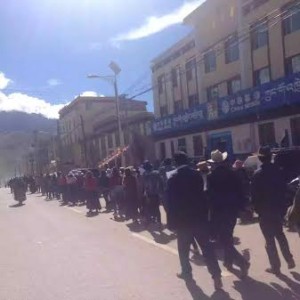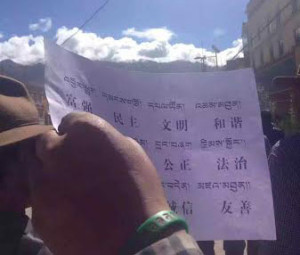
Chinese security forces have detained at least 10 Tibetan residents of Chumey Village in Nyakla Township in Nangchen (Ch: Nangqian) County, Yulshul (Ch: Yushu) Tibetan Autonomous Prefecture, Qinghai Province, according to exile Tibetan sources.
The arrests were made after Tibetans from the village staged a peaceful protest, calling for an equal distribution of welfare benefits provided by the government for Tibetan families.
These government benefits, as the Nangchen County Economic Development Council announced recently, include projects to build new houses and provide scholarships to students in the village.
However, about 100 Tibetans from Nangchen were refused the welfare benefits, including housing benefits. The reason for local authorities’ refusal was that these families had moved to other areas to seek temporary work and schooling for their children.
As a result, around hundred Tibetans from families who were refused government benefits gathered in front of the Nangchen County government office to appeal against the decision. The appeal was followed by demonstrations. Photos show Tibetan protesters carrying leaflets bearing the often-repeated Chinese government slogans such as Prosperity, Democracy, Civilization, Harmony, Honesty and Rule of Law.
“Instead of listening to the Tibetan grievances, the Chinese authorities arrested ten Tibetans,” a source with knowledge of the incident told TCHRD.

Nangchen County is part of the Sanjiangyuan National Nature Reserve (SNNR) or the Three Rivers Nature Reserve, which China created to protect the source of three major rivers: Machu (Yellow River), Drichu (Yangtze River), and Zachu (Mekong). To ensure water supply to parched Chinese cities and towns, thousands of Tibetan nomads in the SNNR area were uprooted, dispossessed of their ancestral lands with little or no compensation, and no prospects for steady employment in a cash economy. By 2004, authorities had relocated all the nomads in Nyakla Township to make way for SNNR. Little wonder that these former nomads have now become temporary, migrant workers forced to move to other towns to find employment and schooling for their children.
Not only the nomads from Nangchen County but also nomads from other villages have been subjected to displacement, all under the guise of grassland protection and Sanjiangyuan National Nature Reserve.
In 2000, the areas in Qinghai through which the rivers Machu, Drichu and Zachu flow were declared “National Nature Reserve” by the Chinese government. The project/policy to locate [displace] nomads to [other areas] in the name of grassland protection were implemented from 2005.
The areas that constitute the so-called Sanjiangyuan National Nature Reserve include southern parts of Qinghai province, 16 counties from the four Tibetan Autonomous prefectures of Yulshul, Golok (Ch: Guoluo), Tsolho (Ch: Hainan) and Malho (Ch: Huangnan), and Dangla Township located in the Tsonub Tibetan Autonomous Prefecture.
In total, these areas cover more than 302,500 square kilometers, constituting more than 43 percent of the total area of Qinghai province. And these areas are inhabited by more than 556,000 people, out of which 90 percent are Tibetans.
According to Li Xiao Nan, deputy head of the Qinghai Development and Reform Commission, who is also the head of the Sanjiangyuan National Nature Reserve (SNNR) or the Three Rivers Nature Reserve, “up to the end of 2014, all the projects of the first stage of development of the Sanjiangyuan National Nature Reserve (SNNR) or the Three Rivers Nature Reserve have been completed by the government; on these [projects] 77.12 billion Chinese Yuan have been spent. 84,710,000 mu of grassland have been protected [that is fenced] and 55,773 nomads have been settled [displaced] in [other areas].”
Moreover, the projects of the second stage of [development SNNR] would begin and last from 2014 to 2020, upon which 160.6 billion Chinese Yuan shall be spent. It has been planned that [projects of the second stage of development of SNNR] would cover an area of 395,000 square kilometers, up from 152,300 square kilometers that was initially planned to cover, constituting 54.6 percent of the total area of Qinghai.
Using a carrot and stick approach, and in the name of grassland protection, the Chinese government is forcing the Tibetan nomads to leave their ancestral homelands and settle in other areas and townships. The nomads are being promised that they will be given adequate compensation, including better living standards, housing facilities, job training that will eventually fetch them jobs, pensions for old people, schooling for children and so on. But this state engineered displacement policy is destroying the centuries-old Tibetan nomadic life. As nomads are not used to a settled way of life, they are facing serious crises.
Recently, Qinghai province issued a report on the livelihood of the resettled nomads. In the report “only 30 percent of the displaced nomads have received facilities/compensation that will ensure the continuation of their livelihood.” This means out of 50,000 nomads who have been displaced in the name of the SNNR, 30,000 have not been given adequate facilities that will help them start a new livelihood. Moreover, the fact that nomads are now being resettled in the cities means they are being assimilated in the larger Han Chinese population; in the process nomads are increasingly being alienated from their own language, culture and history.
However, all these displacement and uprooting of the nomads from their ancestral lands and culture are being carried out in the name of protecting the environment of the Tibetan plateau. The Chinese government proclaims that the resettling of the nomads is necessary to fight the warming of the Tibetan plateau, which they say, is caused by the rise of population and increasing human activity. But the truth is that the Chinese government is stealing the nomadic grasslands, all in the name of SNNR. Instead of protecting the environment, the Chinese government is engaged in a lot of mining activities, which is polluting the local environment. And when local Tibetans peacefully protest the environmental and health hazards caused by these mining activities, the Chinese authorities, instead of listening to their genuine grievances, launch violent crackdown. The Tibetan protestors are arrested, beaten and imprisoned. In short, the displacement of nomads is not just about protecting environment, but also about exploiting the mineral resources that are buried under the nomadic lands. It’s the colonization of Tibetan grasslands.
The Tibetan Centre for Human Rights and Democracy (TCHRD) condemns the arrests of 10 known Tibetans in Nangchen County and calls on the local authorities to release them immediately from detention. For all intents and purposes, the demonstrations they staged were peaceful and therefore within the bounds of law. Moreover the demonstration was prompted by the authorities’ refusal to listen to the appeals and grievances expressed by local Tibetans. Chinese authorities must take full responsibility for the impoverishment of Tibetans nomads caused by a series of ill-conceived development policies. It has been proven by independent studies that former nomads have become poorer when compared to incomes they earned as nomads. It is only reasonable that the Chinese authorities provide the former nomads with the help and support that they need.
Endnotes
http://news.xinhuanet.com/local/2015-07/21/c_1115995919.htm
http://www.ndrc.gov.cn/fzgggz/jyysr/jqyw/201502/t20150226_665341.html
